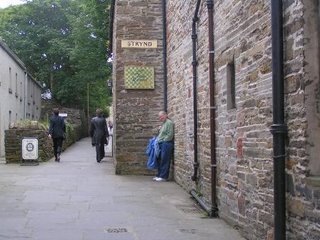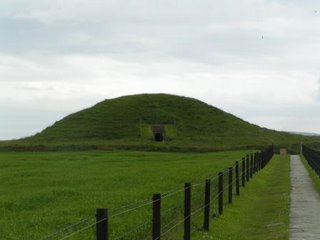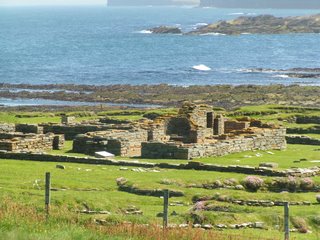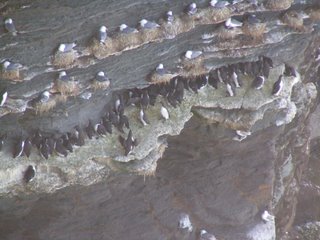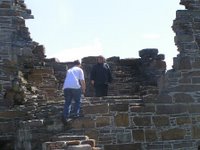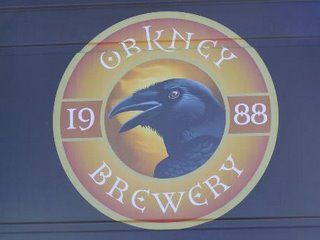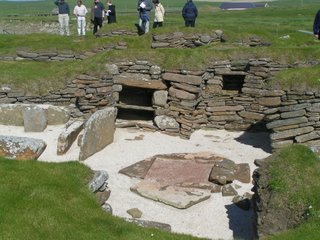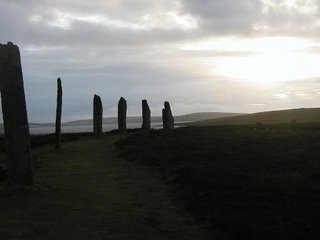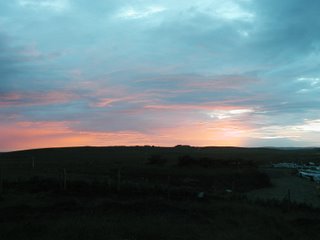 I think when we finally arose from sleep for our final day in the Orkney’s, we were all getting tired of the constantly-on-the-go point-to-point sightseeing. So our agenda for the day was to explore Kirkwall, a city with shops, leisurely eateries, and some minor tourist attractions.
I think when we finally arose from sleep for our final day in the Orkney’s, we were all getting tired of the constantly-on-the-go point-to-point sightseeing. So our agenda for the day was to explore Kirkwall, a city with shops, leisurely eateries, and some minor tourist attractions. It was much bigger a city than Sterness (if indeed you call Sterness a city), but the mood of the town was light. There were plenty of people, but it was not crowded.
We hit up some of the touristy, but still interesting shops for the first time since we got to Scotland. I was very happy to pick up a set of Orkney Brewery coasters and whiskey flavored condoms as gifts, as well as some nice shot glasses.
St. Magnus Cathedral, standing almost central to the city, was just as I expected from the outside (though I cheated by seeing a model of it ahead of time, so of course it was). The inside was a different matter. Outside it stood a significant structure in both height and width, a massive brick-red centerpiece to the city. I could understand how a city was built around a building like this.
On the inside there was little I’d anticipated. As I’d expected it was awe-inspiring, as most churches of a grand magnitude are. Since my trip to Ireland years ago I’ve known the feeling of it; just being inside a structure of such awesome magnitude feels both humbling and awe-inspiring. But what surprised and inspired me about St. Magnus Cathedral was the craftsmanship of everything inside the church. Chairs, desks, and certain pews were covered in ornate hand-carved designs. The pews behind the alter in particular all had figures carved into them. Some where animals, some where of people, but they were all ornate, grand, and impressive carvings. There were even wooden archways between rooms covered in these elaborate carvings.
Then, of course, there were the historical relics kept in the Cathedral. There was a very large and very old graveyard they kept outside. But several of their older gravestones had been moved inside for conservation. Several of the gravestones had elaborate pictures engraved upon them, and they had a rather clear theme. Most of these graves have skull and crossbones engraved on them, others hourglasses with no sand left to pour through. Whatever time period these stones are from, they display an uncomfortably strong fear and inability to deal with death within the culture that carved them. Though they were of the church, they were clearly terrified of the impending doom every person faces. One gravestone even read a eulogy of the deceased, ending with the isolated phase “Remember death.”
It was a truly magnificent structure with truly wondrous contents. I guess people will spare little effort to celebrate God’s beauty.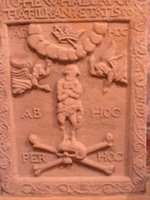
What I haven’t mentioned thus far, is that my father and brother have both been pushing for some fishing again. They’d made a token fishing attempt three times now, but with only a small trout to show for them. They decided it was time for a real trip. So we arranged for a charter boat later in the day to take us out. Fearing that I had already tasted my last Orkney beer on tap (an experience I fear I may never have again) I insisted that we go for a pint ahead of time. So we did, and my pilgrimage was finalized with a pint and a half of Dark Island on tap, and tasted superior to the last I’d had. It was a perfect end.
The fishing trip turned out to be more of an experience than I could have guessed. It was a tiny ship to be out on the ocean, there were a total of 10 of us I think, and that was crowded. First, the guide brought us to a good mackerel spot. Privately, I suspect this was to make sure everyone started in good spirits. Why? Because catching mackrel was as easy as putting your line into the water. We would no sooner stick our hooks into the water than we could start reeling them in, with not one, but two or three mackerel on the line.
I don’t speak of small fish, either. I’ve fished every now and again casually for my entire life. These were easily some of the biggest fish I’ve ever seen caught, let alone caught myself in sets of 2-3. By the time we moved onto another spot, we had a huge bucket of fish, and no one on the boat could have caught less than a dozen. The bucket alone probably could have fed every person on the ship in addition to their families, but we moved on.
The other spots were intended to catch other types of fish, but for the most part was a failure. Our biggest obstacle is that in order to get to the bottom of the waters, where the deep sea fish were, our bait had to make it through the swarms of mackerel. Not only were we still catching mackerel by the dozen, we couldn’t get our bait past them! By the end of the night we were all pulling up the line with three of the biggest fish we’d ever caught on it, and sighing wearily and complaining “Oh, only more mackerel!” and toss it to the seagulls behind us.
Oh, and the seagulls… we aren’t talking about a few gulls. The Seagulls may be bird brained, but they recognize an opportunity when they see it. When we first left harbor, we had a flock of gulls in our wake, but as we went further and further out it seemed that they got tired and gave up. They sometimes gave up so quickly that I suspected they were merely using the boat to play in the gusts of wind it left behind it. All I know is that once the boat stopped and began pulling up mackerel by the dozen, I looked up and there were at least 3 dozen large seagulls bobbing in the water just behind the boat.
There were seagulls of the sort local to Maryland, an assortment of smaller white gulls that looked similar to them but with different grayish beaks, and then there were brown gulls with a hearty strong look of intelligence about them (I know, intelligent looking gulls? It’s beyond belief). Of course I may simply have mistook their aggressive paranoia for intelligence, as the brown gull was clearly dominant.
Watching them, it occurs to me that football must owe its origins to someone watching seagulls. Once we throw a fish to them, 6 or 7 jump right after it at once, and the struggle is often quite lengthy. But the winner of the fish never dares attempting to eat the fish there and then. Instead, once they have a grip on it, they bolt. Trying to escape with the fish is no easy task, because the dozens of gulls that didn’t react quickly enough initially are all just waiting for their chance.
If the fish-holding gull is successfully tackled, he may drop it, and the game begins anew. Otherwise, he might be able to successfully fend off his attacker and fly to some spot that gives them momentary safety. The winner never bothers chewing, there’s no time. He just tosses his head back and swallows a fish larger than his head whole.
It’s a pretty amazing spectacle, and frankly I wish the birds would make some teams, because it’s much more interesting to watch than football.
The best gull spectacle happened when we first decided to change fishing spots. As we started the engine, one of the largest flocks of gulls I’ve ever seen, in their huge assortment rose up into the air to follow us in an almost regimental formation. The gulls were faster than we were, and their speeds were harder for them to control. One look at the wake of our ship would have made Alfred Hitchcock piss his pants.
By the time we got back from the fishing it was so late at night that the sun had almost set. Fishing isn’t my favorite activity, but it was nonetheless an excellent last day in the Orkney’s.